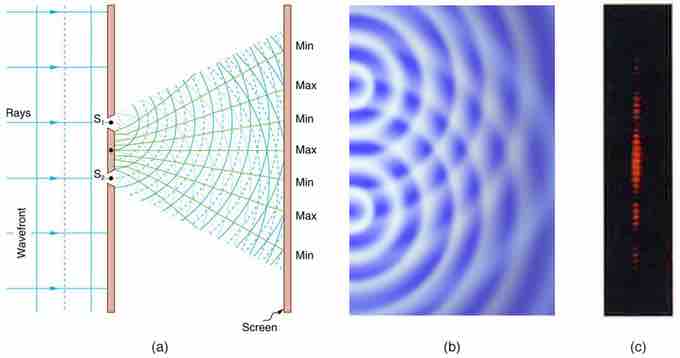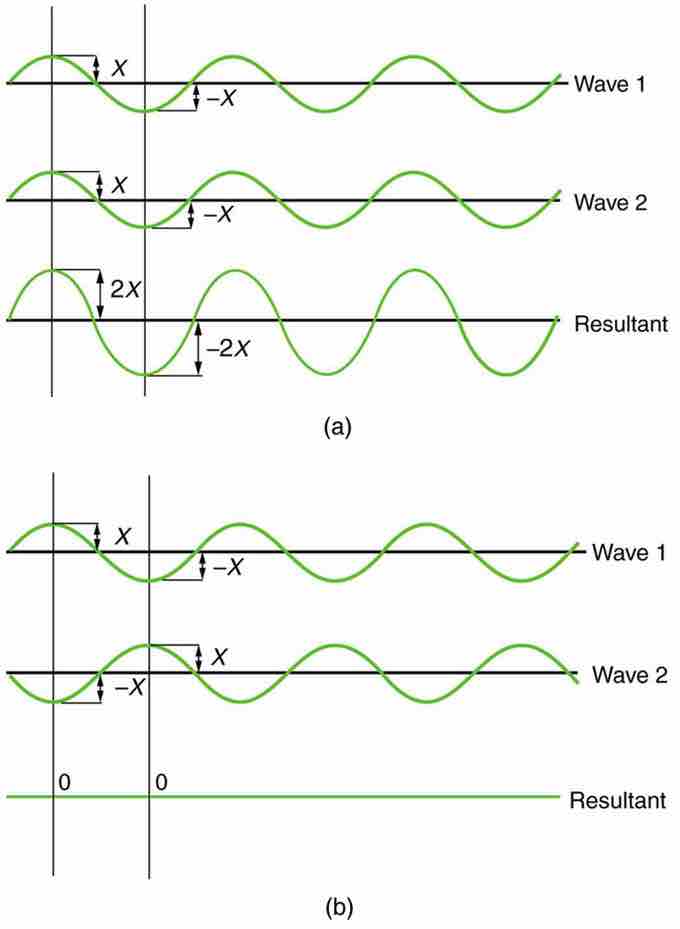The double-slit experiment, also called Young's experiment, shows that matter and energy can display both wave and particle characteristics. As we discussed in the atom about the Huygens principle, Christiaan Huygens proved in 1628 that light was a wave. But some people disagreed with him, most notably Isaac Newton. Newton felt that color, interference, and diffraction effects needed a better explanation. People did not accept the theory that light was a wave until 1801, when English physicist Thomas Young performed his double-slit experiment. In his experiment, he sent light through two closely spaced vertical slits and observed the resulting pattern on the wall behind them. The pattern that resulted can be seen in .

Young's Double Slit Experiment
Light is sent through two vertical slits and is diffracted into a pattern of vertical lines spread out horizontally. Without diffraction and interference, the light would simply make two lines on the screen.
Wave-Particle Duality
The wave characteristics of light cause the light to pass through the slits and interfere with itself, producing the light and dark areas on the wall behind the slits. The light that appears on the wall behind the slits is scattered and absorbed by the wall, which is a characteristic of a particle.
Young's Experiment
Why was Young's experiment so much more credible than Huygens'? Because, while Huygens' was correct, he could not demonstrate that light acted as a wave, while the double-slit experiment shows this very clearly. Since light has relatively short wavelengths, to show wave effects it must interact with something small -- Young's small, closely spaced slits worked.
The example in uses two coherent light sources of a single monochromatic wavelength for simplicity. (This means that the light sources were in the same phase. ) The two slits cause the two coherent light sources to interfere with each other either constructively or destructively.
Constructive and Destructive Wave Interference
Constructive wave interference occurs when waves interfere with each other crest-to-crest (peak-to-peak) or trough-to-trough (valley-to-valley) and the waves are exactly in phase with each other. This amplifies the resultant wave. Destructive wave interference occurs when waves interfere with each other crest-to-trough (peak-to-valley) and are exactly out of phase with each other. This cancels out any wave and results in no light. These concepts are shown in . It should be noted that this example uses a single, monochromatic wavelength, which is not common in real life; a more practical example is shown in .

Practical Constructive and Destructive Wave Interference
Double slits produce two coherent sources of waves that interfere. (a) Light spreads out (diffracts) from each slit because the slits are narrow. These waves overlap and interfere constructively (bright lines) and destructively (dark regions). We can only see this if the light falls onto a screen and is scattered into our eyes. (b) Double-slit interference pattern for water waves are nearly identical to that for light. Wave action is greatest in regions of constructive interference and least in regions of destructive interference. (c) When light that has passed through double slits falls on a screen, we see a pattern such as this.

Theoretical Constructive and Destructive Wave Interference
The amplitudes of waves add together. (a) Pure constructive interference is obtained when identical waves are in phase. (b) Pure destructive interference occurs when identical waves are exactly out of phase (shifted by half a wavelength).
The pattern that results from double-slit diffraction is not random, although it may seem that way. Each slit is a different distance from a given point on the wall behind it. For each different distance, a different number of wavelengths fit into that path. The waves all start out in phase (matching crest-to-crest), but depending on the distance of the point on the wall from the slit, they could be in phase at that point and interfere constructively, or they could end up out of phase and interfere with each other destructively.